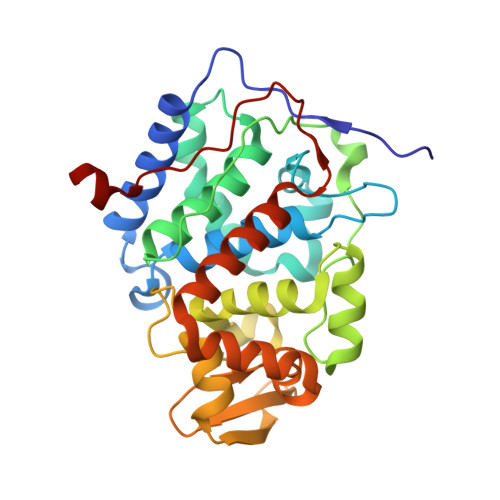Cation-induced stabilization of the engineered cation-binding loop in cytochrome c peroxidase (CcP).
Bhaskar, B., Bonagura, C.A., Li, H., Poulos, T.L.(2002) Biochemistry 41: 2684-2693
- PubMed: 11851415
- DOI: https://doi.org/10.1021/bi011599y
- Primary Citation of Related Structures:
1JCI - PubMed Abstract:
We have previously shown that the K(+) site found in the proximal heme pocket of ascorbate peroxidase (APX) could be successfully engineered into the closely homologous cytochrome c peroxidase (CcP) [Bonagura et al., (1996) Biochemistry 35, 6107-6115; Bonagura et al. (1999) Biochemistry 38, 5538-5545]. In addition, specificity could be switched to binding Ca(2+) as found in other peroxidases [Bonagura et al. (1999) J. Biol. Chem. 274, 37827-37833]. The introduction of a proximal cation-binding site also promotes conversion of the Trp191 containing cation-binding loop from a "closed" to an "open" conformer. In the present study we have changed a crucial hinge residue of the cation-binding loop, Asn195, to Pro which stabilizes the loop, albeit, only in the presence of bound K(+). The crystal structure of this mutant, N195PK2, has been refined to 1.9 A. As predicted, introduction of this crucial hinge residue stabilizes the cation-binding loop in the presence of the bound K(+). As in earlier work, the characteristic EPR signal of Trp191 cation radical becomes progressively weaker with increasing [K(+)] and the lifetime of the Trp191 radical also has been considerably shortened in this mutant. This mutant CcP exhibits reduced enzyme activity, which could be titrated to lower levels with increasing [K(+)] when horse heart cytochrome c is the substrate. However, with yeast cytochrome c as the substrate, the mutant was as active as wild-type at low ionic strength, but 40-fold lower at high ionic strength. We attribute this difference to a change in the rate-limiting step as a function of ionic strength when yeast cytochrome c is the substrate.
Organizational Affiliation:
Department of Molecular Biology, University of California-Irvine, Irvine, California 92697-3900, USA.
















